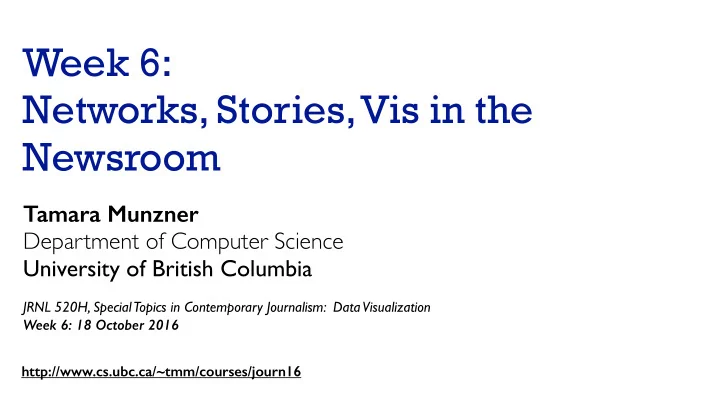

Week 6: Networks, Stories, Vis in the Newsroom Tamara Munzner Department of Computer Science University of British Columbia JRNL 520H, Special Topics in Contemporary Journalism: Data Visualization Week 6: 18 October 2016 http://www.cs.ubc.ca/~tmm/courses/journ16
News • Assignment 3, 4, 4-solo marks out –Assign 4: 90% pair mark, 10% solo mark for proposal • Assign 4 pair: min 74.8, avg 84.2, max 100 • Assign 4 solo: min 50, avg 89.7, max 100 (5% of Assign 6 grade weight) –Assign 3 • min 83.8, avg 93.6, max 100 • things to watch out for –diverging vs sequential colormaps –line charts vs bar charts (continuous vs discrete data) –absolute counts vs relative percentages –highlighting/emphasis vs filtering out completely • does your interaction make sense? does it help somebody? –please submit packaged workbooks (twbx) not plain workbooks (twb) 2
Schedule • today: office hours12:30-1:30pm, Tamara & Caitlin • next week: –Tamara on travel Sat Oct 22 - Sat Oct 29 • at VIS conference in Baltimore, likely extremely slow with email –Caitlin here • Tue Oct 25 9:30-12:30, 1:30-4:30 in Sing Tao bldg room 313, drop by for help/discussion • available by email throughout the week • two weeks: –project 6 due Tue Nov 1 9am 3
Today • stories • networks • (break) • vis in the news • beyond this class • individual meetings on final project 4
Assignment 6 • find dataset, visualize it, and write story about it –you’ve now had practice in • effective visual encoding: space, color • finding the story within a dataset • wrangling • linking up and partitioning into multiple views • you’re encouraged to consult with us if you get stuck! –is your idea viable/newsworthy? –how can you do what you want inside Tableau? –is your visual encoding well justified? • you’re encouraged to post story publicly (but not required) –note you can embed vis within web page with Tableau Public 5
Last Time 6
Last Time: Rules of Thumb • No unjustified 3D • Resolution over immersion • Overview first, zoom and filter, details on demand • Responsiveness is required • Function first, form next 7
Demos 1 & 2: Wrangling Tutorial, Simple Survey • Credit: Caitlin Havlak • Wrangling Lessons –first row for headers (right menu over source in –Tableau data interpeter –manual Excel/GoogleDoc cleaning • Big Ideas –reshaping data: from wide to tall –joins: inner, left, right, outer –pivots: one observation per row, no cross-tabulation 8
Stories 9
Networks 10
How? Encode Manipulate Facet Encode Manipulate Facet Reduce Map Arrange Change Juxtapose Filter from categorical and ordered Express Separate attributes Color Saturation Hue Luminance Select Partition Aggregate Order Align Size, Angle, Curvature, ... Use Navigate Superimpose Embed Shape Motion Direction, Rate, Frequency, ... 11
Arrange networks and trees Node–Link Diagrams Connection Marks NETWORKS TREES Adjacency Matrix Derived Table NETWORKS TREES Enclosure Containment Marks NETWORKS TREES 12
Idiom: force-directed placement • visual encoding –link connection marks, node point marks • considerations –spatial position: no meaning directly encoded • left free to minimize crossings –proximity semantics? • sometimes meaningful • sometimes arbitrary, artifact of layout algorithm • tension with length – long edges more visually salient than short • tasks –explore topology; locate paths, clusters • scalability –node/edge density E < 4N http://mbostock.github.com/d3/ex/force.html 13
Idiom: adjacency matrix view • data: network –transform into same data/encoding as heatmap • derived data: table from network [NodeTrix: a Hybrid Visualization of Social Networks. Henry, Fekete, and McGuffin. IEEE TVCG (Proc. InfoVis) 13(6):1302-1309, 2007.] –1 quant attrib • weighted edge between nodes –2 categ attribs: node list x 2 • visual encoding –cell shows presence/absence of edge • scalability –1K nodes, 1M edges [Points of view: Networks. Gehlenborg and Wong. Nature Methods 9:115.] 14
Connection vs. adjacency comparison • adjacency matrix strengths –predictability, scalability, supports reordering –some topology tasks trainable • node-link diagram strengths –topology understanding, path tracing –intuitive, no training needed http://www.michaelmcguffin.com/courses/vis/patternsInAdjacencyMatrix.png • empirical study –node-link best for small networks –matrix best for large networks • if tasks don’t involve topological structure! [On the readability of graphs using node-link and matrix-based representations: a controlled experiment and statistical analysis. Ghoniem, Fekete, and Castagliola. Information Visualization 4:2 (2005), 114–135.] 15
Recommend
More recommend